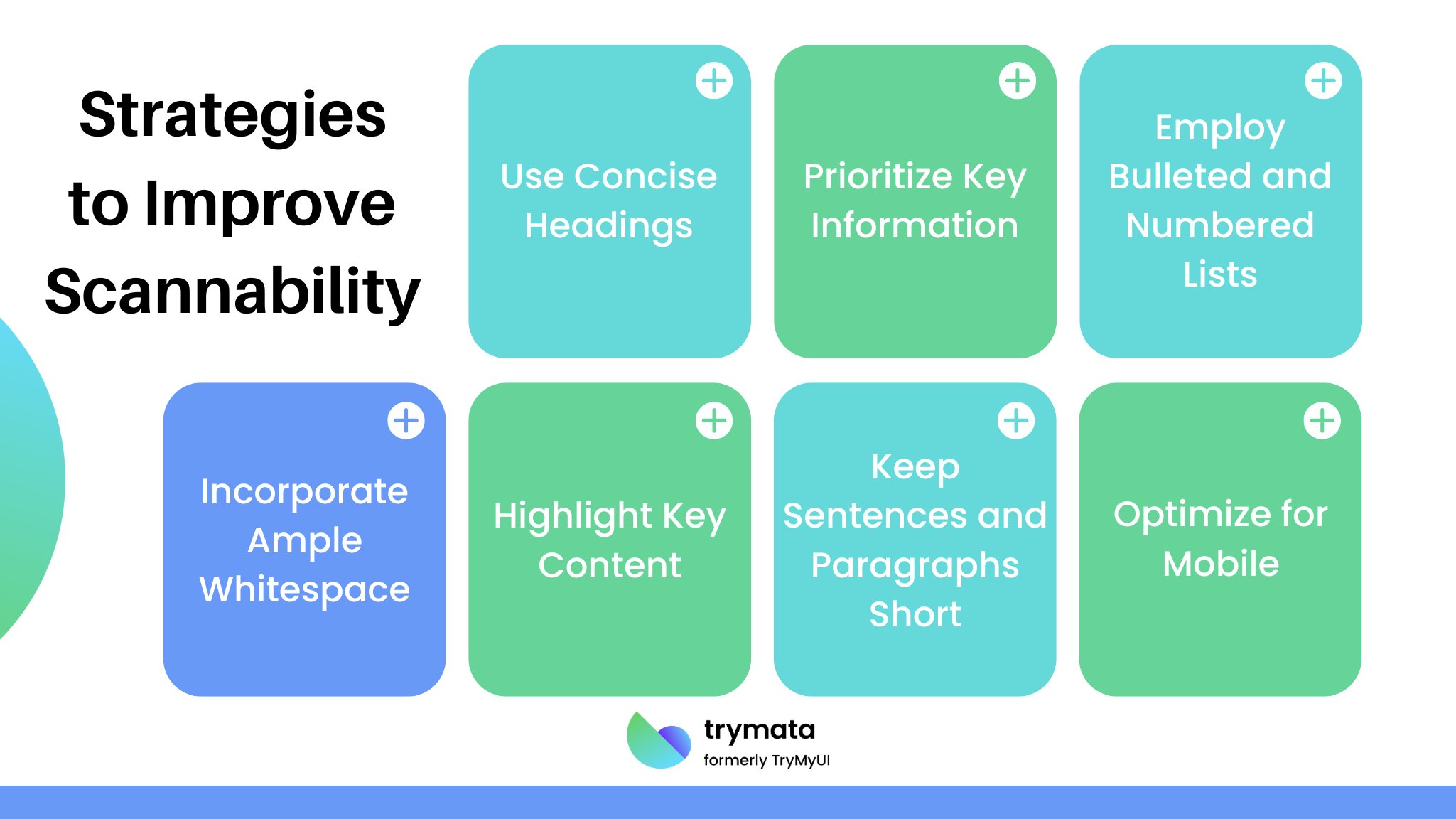Scannability, the art of making content easy to navigate and digest, has emerged as a key factor in creating impactful user experiences. Concise writing techniques, clear structure, and strategic visual cues make content more accessible, reducing cognitive effort and increasing engagement.
This blog explores why scannability matters, how it influences user behavior, and practical strategies to optimize content for effortless navigation. Whether you’re crafting web pages, articles, or marketing materials, mastering scannability can enhance retention, improve conversions, and build lasting connections with your audience.
What is Scannability?
Scannability refers to the ease with which a user scan quickly and comprehends content, whether a webpage, document, or article. Online readers rarely read every word; instead, they rely on visual reference points like headings, subheadings, and bulleted lists to extract the most important information.
Creating scannable content involves crafting concise sentences, breaking complex information into digestible parts, and adding structure to your online text. This reduces cognitive load and makes it easier for users to scan and absorb key information quickly.
Why Scannability Matters
Understanding why scannability matters are the first step toward creating user-friendly content. Here’s how it impacts user behavior and engagement.
- Users Scan, Not Read: Studies show most people don’t read online articles word-for-word. Instead, they scan for key information using visual reference points like headings, bulleted lists and pull quotes.
- Improves User Experience: Providing users with content that’s easy to scan reduces mental energy spent on navigation. Concise sentences, short paragraphs, and a clear structure help users engage with your page effectively.
- Boosts Retention and Conversion: Scannable content ensures that readers retain the most important elements of your message. This can translate into higher engagement, longer page visits, and better conversion rates.
How to Optimize for Scannability?
Making your content scannable isn’t difficult, but it requires deliberate effort. These practical tips will help you craft content that readers can navigate with ease:
1. Use Concise Headings and Subheadings
Headings act as signposts for readers. Use concise phrases to summarize sections, ensuring that important words stand out. For example, “How to Test Scannability” is clear and actionable.
2. Break Content into Short Paragraphs
Avoid long blocks of text. Short paragraphs enhance readability by reducing cognitive load. Each paragraph should focus on one idea to make scanning easier for users.
3. Incorporate Visual Reference Points
Visual cues guide readers through the content, such as
- Bold text,
- Iitalics,
- Pull quotes and
- Bulleted lists.
These elements highlight key points, making the text on your page easily scannable.
4. Adopt the F-Pattern Layout
Studies on user behavior reveal that online readers often scan in an “F” pattern. To align with this natural reading flow, place key information along the top and left sides of the webpage.
5. Utilize Ample Whitespace
Whitespace, or negative space, gives your content room to breathe. It reduces visual clutter, allowing users to focus on important elements without feeling overwhelmed.
6. Use Lists and Tables
Numbered lists and tables are excellent for organizing complex information. They’re easy to scan and help readers find what they need quickly.
7. Choose Readable Fonts
Readable fonts make a significant difference in scannability. Select fonts that are clean and professional, with sufficient size and spacing.
How to Test Scannability?
Testing scannability ensures that your content strategy meets user expectations. Here are some methods to evaluate its effectiveness.
- Usability Testing: Conduct usability testing sessions to observe how users interact with your webpage. See if they can locate important elements and complete tasks efficiently.
- Eye-Tracking Studies: Eye-tracking research helps determine how users’ eyes move across a webpage. These studies reveal whether your content aligns with natural scanning patterns like the F-pattern.
- Feedback and Analytics: Use analytics tools to monitor metrics such as time on page and bounce rates. Combine this data with direct user feedback to identify areas for improvement.
- Test Content with A/B Methods: Compare different content structures to test scannability. Experiment with headings, spacing, and formatting variations to determine what resonates most with your audience.
Strategies to Improve Scannability
Improving scannability doesn’t require a complete overhaul. With these practical strategies, you can quickly elevate the readability and usability of your content:

1. Use Concise Headings
Headings act as signposts for readers, guiding them effortlessly to the relevant sections. Craft concise headings that accurately convey the essence of the content beneath them.
2. Prioritize Key Information
Place important words and key points at the beginning of sentences and paragraphs. This ensures readers immediately grasp the main idea, even if they’re only skimming.
3. Employ Bulleted and Numbered Lists
Lists provide a structured and visually appealing way to present information. They can help you break down complex ideas into manageable, scannable chunks.
4. Incorporate Ample Whitespace
Whitespace isn’t wasted space; it’s a strategic tool to reduce cognitive load. Surround text and visual elements with ample breathing room to enhance focus and clarity.
5. Highlight Key Content
Strategically use bold, italics, or pull quotes to highlight critical details. This approach helps key points stand out without overwhelming the reader.
6. Keep Sentences and Paragraphs Short
Lengthy blocks of text can deter readers. Opt for short, concise sentences and paragraphs to maintain flow and improve readability.
7. Optimize for Mobile
Ensure your content remains scannable on different devices. Responsive design, legible fonts, and touch-friendly spacing are crucial for mobile usability.
Measuring the Impact of Improved Scannability
Measuring the results is crucial once you’ve optimized your content for scannability. Here are some things to look for.
- Improved Engagement Metrics: Due to improved scannability, analytics can show increased time spent on pages, lower bounce rates, and higher click-through rates.
- Better Usability Test Results: Positive feedback during usability testing and smoother task completion rates indicate successful optimization.
- Increased Conversions: Scannable content simplifies decision-making processes, leading to better conversion rates.
- Enhanced User Satisfaction: When users can find and absorb relevant information effortlessly, their overall satisfaction with your site is boosted.
Future Trends in Scannability
As digital landscapes evolve, scannability strategies must adapt. These trends offer a glimpse into the future of user-friendly content.
- AI-Assisted Content Creation: AI tools can help writers generate scannable content by suggesting concise sentences, emphasizing key points, and optimizing structure.
- Interactive Content: Features like collapsible headings and interactive elements allow users to control how much content they scan and read.
- Personalization: Writers can use user research and analytics to tailor scannable content to specific audience needs, ensuring relevance and usability.
- Advanced Usability Testing Methods: New usability testing technologies will offer deeper insights into how users scan and engage with content across different devices and contexts.
Conclusion
Scannable content is essential for delivering value that resonates with modern users. By focusing on clarity, structure, and user-centric design, you can create content that engages readers, boosts retention, and drives conversions.
Integrating tools like AI and personalization will refine scannability as technology evolves, ensuring your content remains relevant and practical. Adopting these strategies enhances user satisfaction and positions your content as a go-to resource in a competitive digital landscape. Start optimizing for scannability today and watch your audience engagement soar!
Skip Navigation: Boost Web Accessibility and User Experience




